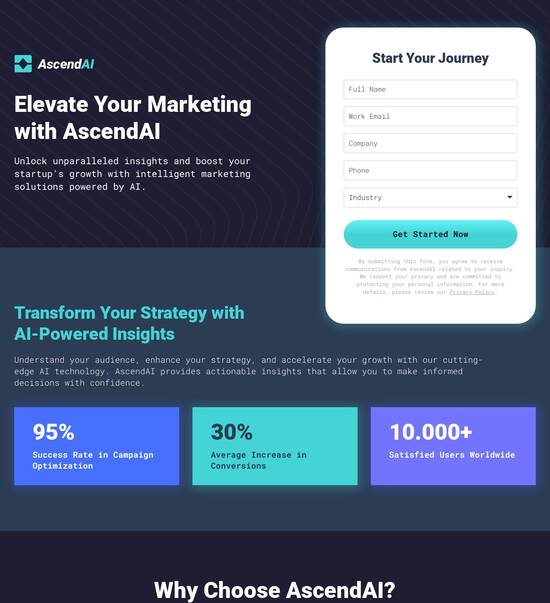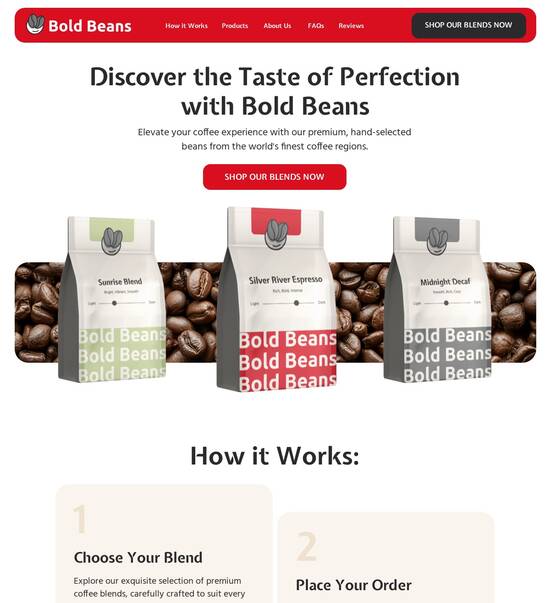
Vue.js optimized API documentation page template
Explore Similar TemplatesAbout template
Supercharge your API documentation page with Vue.js for outstanding performance! Learn more today.
Recommended templates

Easy to build without coding
With the intuitive drag-and-drop builder, anyone on your team can create high-converting pages without any knowledge of code or design. Make enhancements to your landing page with custom widgets using Javascript, HTML/CSS, or third-party scripts.

Multiple layouts for any industry and goal
Select from 500+ landing page layouts built to boost conversions across industry-specific scenarios. Customize them by adjusting fonts, adding images, and generating on-brand content with the AI assistant. Quickly scale with Instablocks® and Global Blocks that you can save, reuse, and update globally.

Loads fast and looks polished on any device
Every template is responsive, which means they present professionally on any device and load blazingly fast with our Thor Render Engine. You can also power them up with Google AMP technology to deliver an unparalleled mobile experience and drive higher conversions.

Robust analytics & experimentation
Get real-time updates and reporting across all your devices, showing the number of visitors, conversions, cost-per-visitor, and cost-per-lead. Launch AI-powered experiments, run A/B tests, and use heatmaps to analyze user behavior, then optimize your landing page to maximize conversions.







Easy to build without coding
With the intuitive drag-and-drop builder, anyone on your team can create high-converting pages without any knowledge of code or design. Make enhancements to your landing page with custom widgets using Javascript, HTML/CSS, or third-party scripts.
Multiple layouts for any industry and goal
Select from 500+ landing page layouts built to boost conversions across industry-specific scenarios. Customize them by adjusting fonts, adding images, and generating on-brand content with the AI assistant. Quickly scale with Instablocks® and Global Blocks that you can save, reuse, and update globally.
Loads fast and looks polished on any device
Every template is responsive, which means they present professionally on any device and load blazingly fast with our Thor Render Engine.
Robust analytics & experimentation
Get real-time updates and reporting across all your devices, showing the number of visitors, conversions, cost-per-visitor, and cost-per-lead. Launch AI-powered experiments, run A/B tests, and use heatmaps to analyze user behavior, then optimize your landing page to maximize conversions.
All the features you need to build lead-generating landing pages
Explore more featuresLearn how to build top-performing landing pages for any goal
FAQs
Leading the way in building high-performing landing pages





A comprehensive guide to optimizing landing pages with Instapage
In today's competitive digital landscape, marketers need to optimize their landing pages for maximum conversions. Instapage stands out as the most powerful landing page and conversion rate optimization (CRO) platform designed to meet the unique needs of marketers in various industries across the USA. This step-by-step guide will explore how to harness the power of Instapage to enhance your campaigns and maximize ROI, regardless of your budget or team size.
Understanding the importance of landing pages
Landing pages serve as a critical touchpoint in your digital marketing efforts. An effective landing page not only captures user attention but also prompts them to take specific actions. With Instapage, you have access to over 100 high-converting templates and lead generation elements, allowing for quicker campaign launches and better user engagement.
- High-converting templates: Leverage ready-to-use templates tailored for specific goals.
- Lead generation elements: Incorporate forms and calls-to-action to capture leads seamlessly.
- Intuitive builders: Use drag-and-drop functionality for fast page creation without coding.
Step 1: Building your landing page
Creating an effective landing page starts with understanding your audience. Follow these steps for optimal landing page creation.
- Select a template: Choose from Instapage's library to find a layout that aligns with your campaign objectives.
- Customize content: Use dynamic text replacement to tailor content to the audience’s needs, adapting messaging based on the source of traffic.
- Incorporate visuals: Use images and videos that resonate with your audience to increase engagement.
Step 2: Optimizing for conversions
Optimization plays a vital role in improving your landing page's conversion rate. Consider the following tactics.
- Implement A/B testing: Test different headlines, images, and calls-to-action to determine what works best.
- Utilize heatmaps: Analyze how visitors interact with your page to identify areas for improvement.
- Monitor analytics: Use Instapage's dashboard to review performance metrics and make data-driven decisions.
Step 3: Collaborating for success
Collaboration among team members can significantly enhance the quality and speed of landing page production.
- Real-time editing: Allow team members to make immediate changes during the review process.
- Feedback integration: Gather input from stakeholders to refine pages before launch.
- Secure sharing: Easily share landing pages with external parties for input and modifications.
By following these steps and utilizing the powerful features of Instapage, marketers can create optimized landing pages that effectively drive conversions and enhance overall campaign performance.
Ready to transform your marketing campaigns? Start using Instapage today and discover the difference a well-optimized landing page can make!
VueJS optimized API documentation page template
Understanding the purpose of API documentation
API documentation serves as a crucial bridge between developers and the application's capabilities. It effectively communicates how other pieces of software can interact with your application, detailing everything from access credentials to usage guidelines. Well-structured API documentation can significantly reduce onboarding time for developers and improve the overall user experience.
The key audience for API documentation includes developers who implement the API, integrators who need to mix and match different systems, and even end-users who might simply want to understand the functionalities offered. Recognizing the different needs of such audiences is fundamental in shaping effective documentation.
Clarity: Documentation must be straightforward and devoid of jargon for broader accessibility.
Comprehensive examples: Providing usage examples allows users to visualize the API function.
Quick reference: A consolidated format enables users to find critical information swiftly.
The role of VueJS in creating dynamic documentation
VueJS is a progressive JavaScript framework known for its reactivity and adaptability. Its ecosystem offers a wide array of tools and libraries that enhance web development capabilities. When it comes to creating API documentation, VueJS stands out due to its component-driven architecture that simplifies complex documentation systems.
Reactivity: Real-time updates allow users to see changes and interact with the documentation dynamically.
Integration: VueJS works seamlessly with libraries like Vue Router and Axios for effective data management.
Design principles for an optimized API documentation template
Blueprinting your documentation structure is critical for clarity and usability. An effective template often contains essential sections - an overview, usage instructions, defined endpoints, and practical examples. Ensuring these core segments are accessible and logically organized is key to an end-user’s experience.
Overview: A clear introduction highlighting the main functionalities of the API.
Endpoints: Detailed descriptions of each API endpoint and its parameters.
Search functionality: Enable users to locate information quickly through a well-implemented search feature.
Advanced techniques for performance optimization
To ensure smooth user experiences, advanced optimization techniques can be employed. Lazy loading is one such technique that can significantly improve load times by loading only the necessary components. When implemented correctly in VueJS, lazy loading allows for a more efficient rendering of components when required.
Rendering efficiency can also be optimized through careful management of the Virtual DOM, which is instrumental in minimizing unnecessary updates. This ensures that resources are used wisely while enhancing the overall performance of the documentation page.
Lazy loading: Load components on-demand to reduce initial load time.
Virtual DOM advantages: Efficient updates help maintain performance, especially in larger applications.
Proper use of props and directives in VueJS
In VueJS, props are essential for component communication. Proper design of props can enhance clarity and functionality. This includes validating data types required by each component and defining default values to ensure robustness. Clarity in prop usage fosters smoother interactions within the documentation.
Additionally, utilizing Vue directives effectively contributes to improved functionality. By employing built-in directives like v-if, v-for, and v-model, developers can enhance user interactions and tailor experiences based on specific user data or application states.
Data types: Specifying expected data types keeps your API predictable and understandable.
Custom directives: Create reusable features that perform specific functionalities, enhancing the documentation.
Handling complexity: managing datasets and applications
Managing datasets effectively starts with structuring them in a way that's easy to access and manipulate. Organizing data in formats like JSON or YAML for API representation allows users to manage the datasets with ease while ensuring that the structure adheres to standard practices. A clear API call mechanism within Vue components ensures that users can fetch data efficiently without hindrance.
Modularity becomes essential, particularly for large-scale applications. By adopting a component-based architecture, developers can create reusable pieces that maintain functionality while being easy to integrate into new parts of the application. Using Vue Router facilitates a seamless navigation experience, allowing users to move through different sections of the documentation without losing context.
Data organization: Utilize standard formats like JSON to keep things structured.
Reusable components: Building components that can be utilized across different sections enhances efficiency.
Strategy for effective updating and version control
To keep documentation aligned with evolving API features, change logs become critical. Documenting changes allows users to understand new additions and remove outdated processes. Implementing a versioning strategy, like semantic versioning, ensures users can track which versions of the documentation correspond to specific API iterations.
Collaboration is vital in maintaining and updating the documentation. Engaging developers and users in the modification process helps in pinpointing essential changes and encourages a sense of ownership towards the documentation. Utilizing collaborative editing tools can streamline this process, ensuring everyone remains on the same page.
Change logs: An organized list of modifications to keep all stakeholders informed.
Collaboration tools: Platforms that encourage input and editing among users.
Skills and tools for the documentation team
For a successful API documentation team, developers need a robust understanding of both VueJS and JavaScript fundamentals. A strong grasp of RESTful APIs and data formats such as JSON and XML is equally essential, providing the team with the knowledge to translate complex technical details into user-friendly documentation.
In addition to skills, the right tools can enhance the documentation process. Using visualization tools like Storybook permits developers to present individual components for review, while knowing when to implement Markdown versus HTML further streamlines the creation process.
Understanding VueJS: A foundational knowledge is critical for any team member.
Effective tools: Leveraging the right technology can facilitate the documentation creation process.
Exploring real-world applications of VueJS documentation templates
Examining successful implementations within the industry reveals how organizations effectively utilize VueJS documentation templates. By analyzing popular open-source projects, we can observe various approaches to documentation structure and user engagement, offering rich insights into best practices.
Moreover, corporate documentation provides excellent examples of how to maintain user-friendly interfaces while delivering technical details. Learning from these case studies illuminates current industry standards and highlights the trends anticipated in future documentation strategies, such as self-documenting and interactive APIs.
Case studies: Investigate top projects to identify successful documentation techniques.
Interactive features: The future is leaning towards documentation that is self-serving and offers an interactive experience.
Fostering community engagement and feedback mechanisms
Encouraging community involvement is vital for the continuous improvement of documentation. Utilizing forums and dedicated feedback tools provides opportunities for users to contribute their thoughts, enhancing the accuracy and relevance of the information presented. By gamifying this contribution, developers can motivate users to take part actively.
To maintain communication with your developer audience, implementing newsletters and update notifications is beneficial. Keeping users informed about the latest documentation alterations and providing new insights jumps the gap between documentation updates and user awareness, enhancing overall engagement.
Community forums: A space for users to voice their opinions and suggestions.
Update notifications: Regular communications keep users in the loop about changes.
Ready to skyrocket conversions?
Supercharge your ad campaigns with high-performing landing pages
Get started














